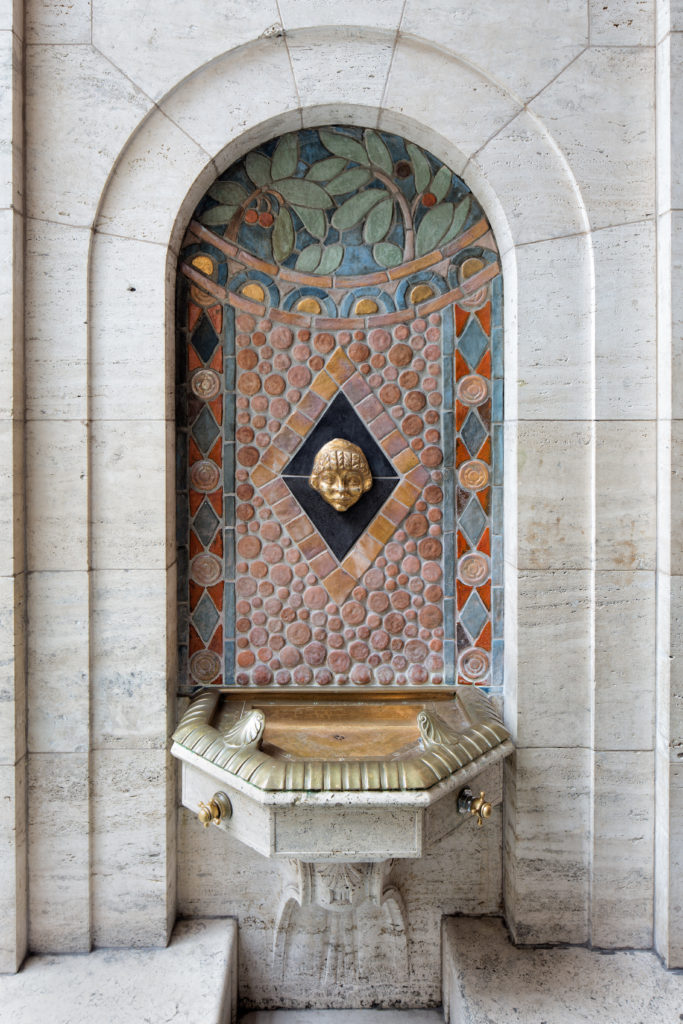
Pewabic tiles at the Detroit Institute of Arts. Courtesy of Pewabic Pottery.
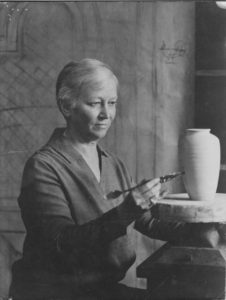
Mary Chase Perry Stratton. Courtesy of Pewabic Pottery.
Her name is synonymous with Detroit, fine art and masterful craftwork: Mary Chase Perry Stratton co-founded Pewabic Pottery and established a legacy within the American Arts and Crafts movement through her vision and strength of personality, building legions of admirers in her lifetime as well as today.
One city that also bears her imprint is Ann Arbor, where Perry Stratton took her first art lessons as a child, received a prestigious honorary Master of Arts degree in 1930, established the first ceramic arts studio at the University of Michigan during World War II, helped built its art museum’s collection and penned a ceramics text that is still in use by artists today, cementing her reputation as an innovator and, interestingly, as a teacher.
“She was a force,” said Annie Dennis, Pewabic’s education director and head of the pottery’s archive, where Dennis is working on digitizing Perry Stratton’s business and personal documents.
As a teacher, Perry Stratton believed in hands-on instruction that allowed her students at U-M as well as Wayne State University to learn through creating their own tools and methods rather than copying hers, Dennis said.
“She was really open about her process as an artist,” Dennis said. “She did a lot of showing by example in the sense that she was like an artist in residence. … She was about independence as an artist and about teaching them as individuals.”

Pewabic tiles at the Detroit Institute of Arts. Courtesy of Pewabic Pottery.
Known as Mary Chase to those closest to her, Perry Stratton was born in 1867 in Hancock, known for copper mining near the Keweenaw Peninsula. Her father, Dr. William Walbridge Perry, moved the family there so he could work as a physician and surgeon for the local mines, including one named Pewabic, a Chippewa term meaning “clay with a copper color,” according to the National Registry of Historic Places. Perry Stratton is said to have created figurines out of the clay, which she found when she took walks with her father.
Tragedy struck in 1877 when her father was murdered, causing her mother Sophia (Barrett) Perry to move them to Ann Arbor, where they had family. At this time, Mary Chase’s brother, Frederick, also attended U-M where he studied pharmacy. The university was a family legacy – both Dr. Perry and his father, William Riley Perry, were alums.
In her unpublished autobiography, “Adventures in Ceramics, The Story of Mary Chase Perry and the Pewabic Pottery,” she wrote, “With the feeling that education was the most important thing in the world, and carrying out my father’s plan of sending Fred to his own Alma Mater, my mother, against the advice of most of her friends, moved with the three children to Ann Arbor.”
There, Sophia encouraged her daughter to explore art, perhaps using some of the money she earned as a boarding housekeeper for university students who were friends of Frederick’s to pay for an art teacher, Lily Chase. Under Chase’s instruction, Perry Stratton painted and sketched, even creating Christmas cards that the budding student was able to sell for a small profit.
Author Cara Catallo, who wrote the book “Pewabic Pottery: A History Handcrafted in Detroit,” noted that Ann Arbor proved an “intellectual atmosphere” for Perry Stratton. In her unpublished autobiography, Perry Stratton talks about Ann Arbor in idyllic terms.
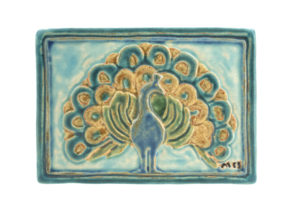
Pewabic peacock tile. Courtesy of Pewabic Pottery.
“I was sent across the campus to a grade school and I loved to feel my heels sink into the soft rounded tar walks and I loved still more the smell of the tar. The Literary Department with its classic dome stood for all culture to me. It had housed my father and I was proud that my grandfather had taken part in the establishment of the university. My path took me through a window of the building in which was installed the beginning of an art collection. Almost daily I took a little turn about the gallery…”
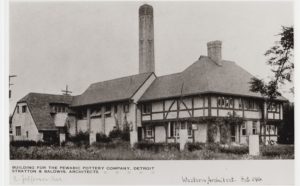
Pewabic Pottery in Detroit, 1916. Courtesy Pewabic Pottery.
The family moved to Detroit to follow Frederick in his career, and Perry Stratton’s artistic life blossomed. She honed her craft, build long-term relationships with other artists and established Pewabic Pottery with co-founder Horace J. Caulkins around 1903. By 1907, they moved operations into the Tudor revival-style building that designed by her husband, William Stratton. Her fame outshone his, however, as a 1918 Detroit Free Press wedding announcement lists Perry Stratton’s name in the headline and only refers to Stratton as a “prominent Detroit architect.”
In 1930, Perry Stratton received an Honorary Master of Arts Degree from the University of Michigan. The award called her a “master artist in the field of ceramics, who, in a pottery conducted in Detroit, has with constructive insight and cunning workmanship perfected glazes and decorative pottery, mosaics, and tiles prized by collectors and architects throughout the country. Inventive in design and happy in execution.”
In her unpublished autobiography, Perry Stratton wrote that the news “seemed a most amazing action, in view of the type of my interest. My path had been in a purely empiric garden, and if I had been able to pick a few flowers stained with cobalt and copper and uranium by the way, they could not be analyzed nor expressed in scientific terms. I had supposed that schools of learning recognized only literary and scientific research, or such work as could be measured by standards of academic training. Of course I was tremendously gratified and pleased that the work I had done should be receive recognition in this way…but even more, it made me rejoice in the name of all craftsmen and creative workers.”
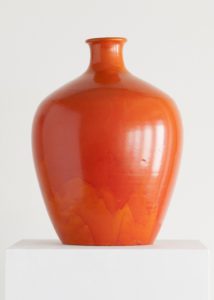
Pewabic Uranium Vase. Courtesy of Pewabic Pottery.
Shortly thereafter, Catallo said Emil Lorch, director of the College of Architecture at U-M, reached out to Perry Stratton to establish a ceramics department. In a 1933 letter, he asked her to join the staff, saying the students “would thus get some knowledge of clay and firing and glazing which might help them design more intelligently.”
Catallo and Dennis said Perry Stratton also had a ceramics studio at U-M while acting as a lecturer from 1940 to 1942, going back and forth from Detroit to Ann Arbor. During that time, she also worked on her textbook, “Ceramic Processes,” which was a basic instructional book on the history of ceramics and the craft of pottery making.
Dennis said World War II put the program on hold, so Perry Stratton and her benefactors channeled her former wages into the purchase of Pewabic Pottery for the U-M Museum of Art, which experts consider “the best documented and most comprehensive of any public collection,” with 46 Pewabic vessels and five tiles. Nearby, there are Pewabic tiles inside the Michigan Union’s first floor bathrooms as well as examples in the Michigan League at its entry and in the Michigan Room on the building’s second floor.
Her work, best known for its luminescent iridescent glaze, is found in homes, the Detroit Public Library, institutions such as the Guardian Building and other sites across the city, state and nation, including the Basilica of the National Shrine of the Immaculate Conception in Washington D.C. Examples of her pottery are found in the Detroit Institute of Arts and the Smithsonian Institution as well as international institutions such as the Louvre Museum in Paris.
Newer installations completed after Perry Stratton’s death at age 94 in 1961 include Third Man Records; Detroit Tigers’ Comerica Park; the Ransom Gillis house, recently rebuilt by the television show “Rehab Addict” as well as the People Mover’s Cadillac station. Today, Pewabic Pottery is Michigan’s only historic pottery and it is designated a National Historic Landmark.
Her legacy, like her influence, remains a force. In the words of her longtime friend, Charles L. Freer: “When our industrial civilization has crumbled to dust, Detroit will be remembered for its Pewabic Pottery.”

